Swiss Alpine flowers in full bloom are one of the most beautiful sights in the Alps mountain range. When the Alps mountains’ bright blossoms surround you in the meadows and high rocky ground of Switzerland, early and mid-summer is the best time to see them.
During this time of year, a short hike up any mountainside will reveal a variety of Swiss mountain flowers, including primroses, heathers, gentians, daisies, bellflowers, and buttercups.
The chance to see rarer flower species that thrive away from populated areas increases as you ascend, passing through the treeline and up to rocky paths and glacier lakes. I was once privileged to spend the entire summer in the Swiss Alps.
A few years ago, I returned to Switzerland and stayed in Zermatt, a small town high in the Alps near Switzerland’s border with Italy. Some of the Swiss alpine flowers I saw during that trip are shared with you here.
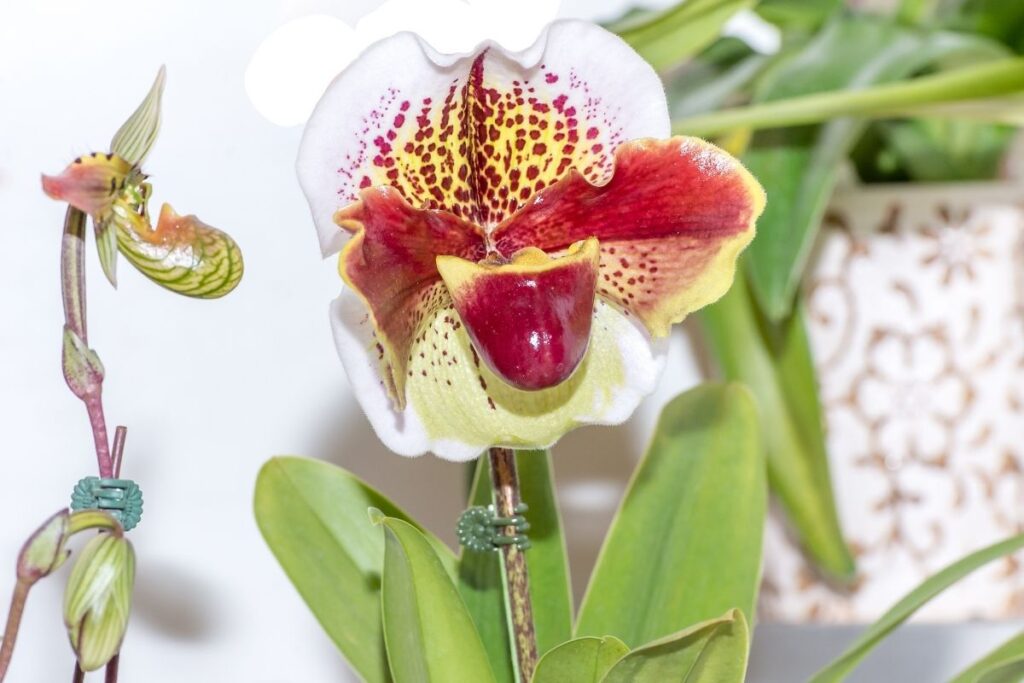
Poisonous And Endangered Flowers
Many Swiss alpine flowers are protected, but others are in danger. Please don’t try and accumulate an impressive collection while out walking.
The Alpine ecosystem’s fragile ecology counts every flower. If you want to keep it as a memento, take a picture of it. Furthermore, some of these flowers are poisonous (some are extremely poisonous).
Violet Flowers
Pretty aster, which I saw on my first nature walk in Zermatt, is one of the pretty violet-coloured alpine flowers. You may also see violet-coloured primroses (Sticky Primrose, Alpine Snowbell).
The endangered German Gentian is also a striking violet shade, which is quite different from the vibrant blue Spring Gentian shown below.
Alpine Toadflax can be found higher up in rocky areas. Common Monkshood and the Pasque Flower, among others, are poisonous. These were not present in my experience.
Blue Flowers
The gentian or bellflower families make up the majority of the blue flowers you’ll see in the Swiss Alps. Gentians, such as the Spring Gentian (pictured), are all protected. Other gentians look like trumpets and bells, despite the fact that the Spring Gentian has separated petals.
Trumpet Gentians were discovered in the mountains around Zermatt. In the Alps, all varieties of bellflower look like hanging bells, which is true. During my mountain hike, I saw the common but beautiful Fairy’s Thimble bellflower.
Many pink alpines belong to the primrose or heather families. A type of primrose, Alpine Rock Jasmine (upper picture), is protected. I found it on rocky ground 3103 metres (1.9 miles) above sea level, where snow still remained at the height of summer.
Purple Saxifrage (lower picture) is pink, despite the name, and was also found on high rocky ground. A deep pink rhododendron gives its name to numerous hotels, including the famous Alpenrose.
Moss Campion, Mountain Thrift, Sowbread (a type of cyclaman), Mountain Houseleek, and Spring Heath are other pink flowers you may see. Most pink alpine flowers are protected, as with other colours. A couple are poisonous.
A List Of The Most Commonly Found Flowers In Switzerland
1. Cembra Pine
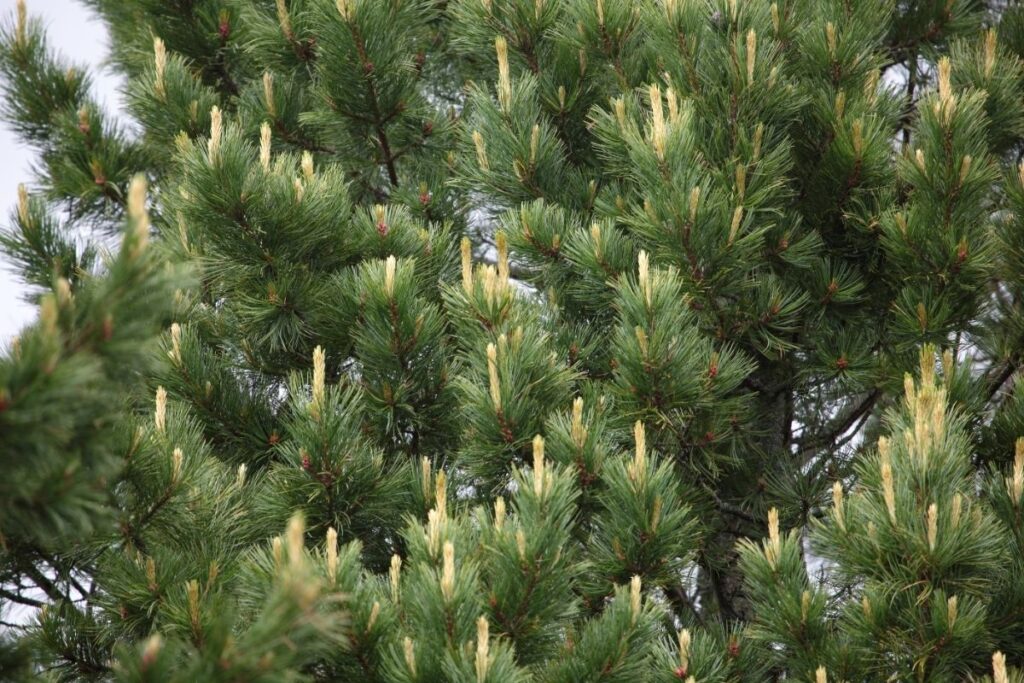
The cembra pine, along with the larch, is frequently found as far up as the forest’s limit. Seeds are produced only every 6 to 10 years. The cembra pine can withstand temperatures as low as -40°C in the winter! Its long, soft needles grow in groups of 5.
A large number of cembra pines produce huge, heavy cones that smell strongly of resin about every ten years. Single small cones are also produced in other years. The nutcracker, which buries nuts for its food reserves, assists cembra pines in the dispersal of their seeds.
A humus-rich soil is required for the cembra pine to germinate. At a depth of 3 to 5 cm in the soil, the cembra pine nuts hidden by the nutcracker find ideal germination conditions.
Many cembra pines have been around for up to 1000 years, and they can tell a lot of stories about harsh weather, lightning, and permafrost. Have you ever smelt the wonderful scent of cembra pine?
Nearly every restaurant in the Engadine has an “Engadinerstube” with cembra pine-clad walls and furniture. Many cembra pines, like this one at the forest’s edge, wage a constant battle with the elements. Several trees bear the scars of this harsh existence.
2. Mountain Pine
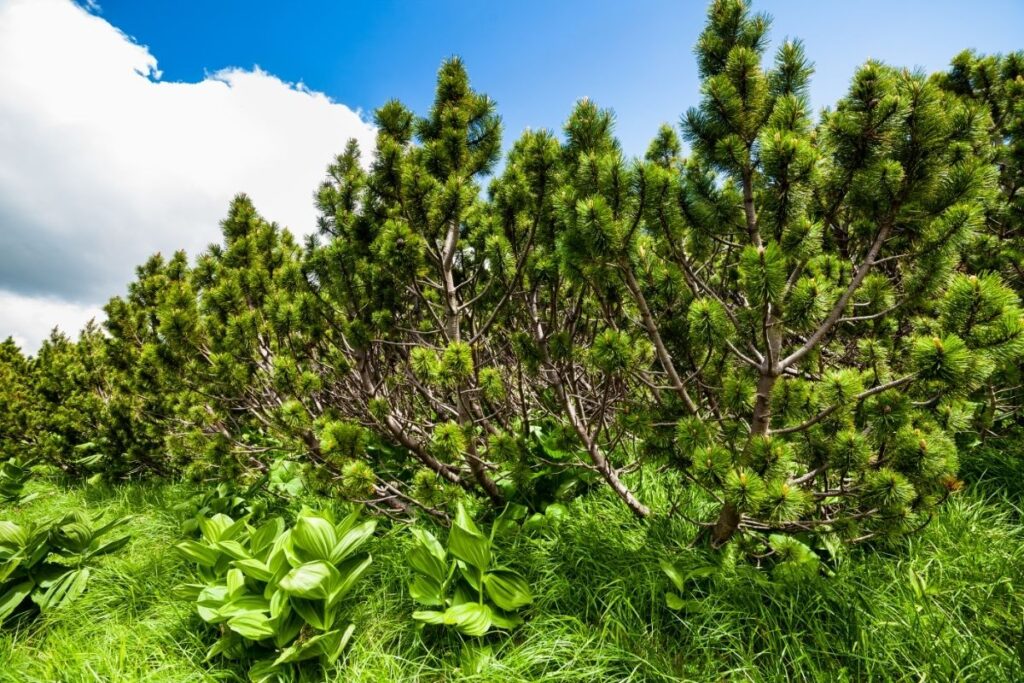
The mountain pine is the most common tree in the Pass dal Fuorn area. Mountain pines come in two types: erect and reclining. Seeds are dispersed by the wind and germinate even on dry, stony ground. Mountain pines were the first trees to recolonise areas left bare by clear felling in the 19th century.
In June, mountain pines bloom. Their short, hard needles grow in pairs, unlike the cembra pine, whose needles grow in clusters of 5. Mountain pines in erect and reclining forms differ in their growth, cones, and habitats.
The erect mountain pine (western Alps) territory in the National Park overlaps that of the reclining mountain pine (eastern Alps). In turn, a wide range of shapes are found. A reclining mountain pine may suddenly rise up, taking on the form of an erect mountain pine.
In heather-mountain pine forests, the erect mountain pine is common in the National Park. Its hook-shaped branches are distinctive, allowing it to be distinguished from cembra pine.
The Val dal Botsch offers numerous opportunities to see mountain pines in their many forms. The reclining mountain pine grows in the forest boundary zone and on steep slopes.
3. Larch
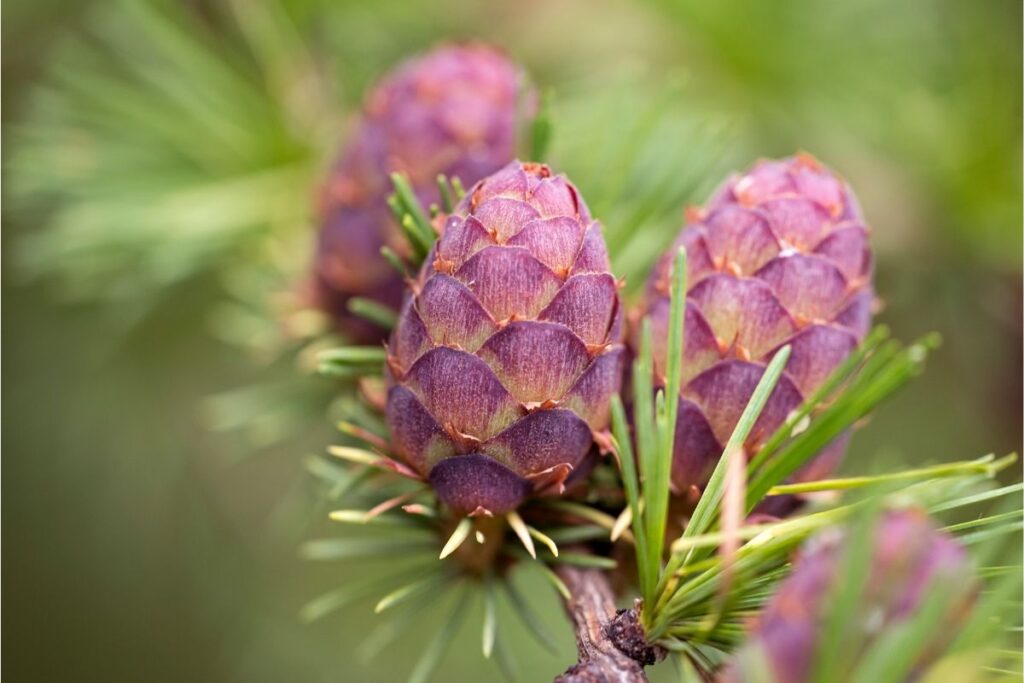
The larch is the most visible of all the conifers in the area, as it appears in various stages: its tender green needles appear in spring, turn golden-yellow in autumn, then shed in November. Although they are not demanding, larches will thrive in almost any soil, but they do require a lot of light to germinate.
They thrive in less dense forests and open areas. New needles appear towards the end of May or early June. The red female flowers open shortly thereafter. This lichen, which is also known as “Wolfsflechte” (wolf’s lichen) in German, is frequently seen on larch trees.
In the past, this highly toxic lichen species was added to wolf bait to poison these unwelcome predators. Up to 2200 metres, larches are common in the National Park. They grow to the forest’s limit together with cembra pines and mountain pines.
This tree does not like fog and a humid environment, which is why it thrives in the Engadine’s dry climate. Ancient trees like this one have barks that can reach up to 30 cm thick, providing excellent lightning and wildlife protection.
A caterpillar attacks the larch about every 9 years. In the summer, the tree tops are already turning brown. The Engadine is characterized by larch-meadow forests. Cembra pine-larch forests used to exist in these areas, but farmers cleared cembra pines for grazing land, leaving only the larches.
4. Norway Sprouce
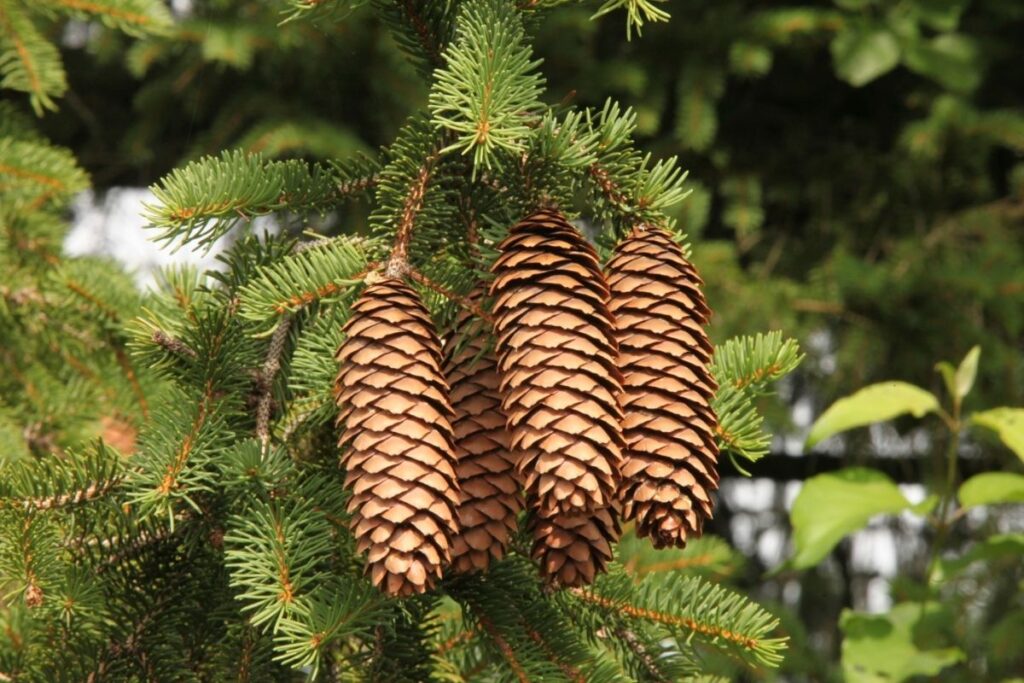
There are fewer spruce trees in the National Park than in other parts of the Alps. Stands of spruce are extremely rare. Mixed forests of larch and Norway spruce are common on the shady slopes of the main Engadine valley.
Norway spruce thrive in an adaptation form that is normally only found in the far north in areas exposed to large amounts of snow, such as south of Punt Praspöl. Snow cannot accumulate on branches that are shorter than usual and are more slender than usual.
Schlangenfichte (snake-spruce) are these trees in German. Norway spruce grows straight and fast, so it is frequently used for timber. Unlike mountain pines and larches, spruce requires very little light for germination and development.
Young spruce and cembra pines grow faster in dense mountain forests like Plan Praspöl (route 8) than larch and mountain pines, which require a lot of light. Browse may have an impact on growth in some areas.
The dark-green evergreen needles are arranged singly around the branches and are only shed after about 6 years. In the autumn, the seeds mature in the hanging cones and are spread by the wind, after which the cones fall to the ground.
5. Moss Campion
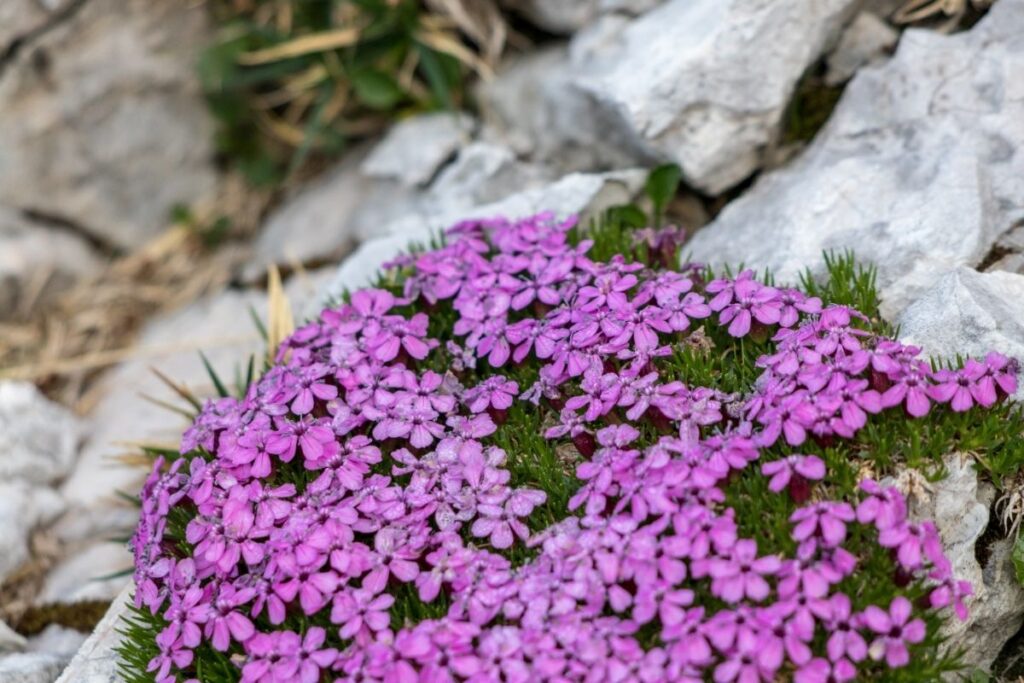
On open grassland and scree, moss campion grows in compact, moss-like cushions, mostly on limestone and dolomite. The tiny pink flowers are held on 3cm long stems. They bloom in the National Park in July and August, depending on the altitude.
Moss campion cushions can reach a diameter of more than a metre. They’re like real recycling factories: their closed form keeps water and heat inside, while dead plant material is transformed into a new supply of food. It takes hundreds of years for a cushion to grow large enough to cover a square metre.
6. Swiss Androsace

A long taproot that allows Swiss androsace to draw on nutrients and water anchors itself in rock crevices. Ball-shaped cushions can be found between 2000 and 3200 metres elevation in the National Park, such as at Fuorcla Val Sasa or Piz Quattervals.
7.Glacier Crowfoot
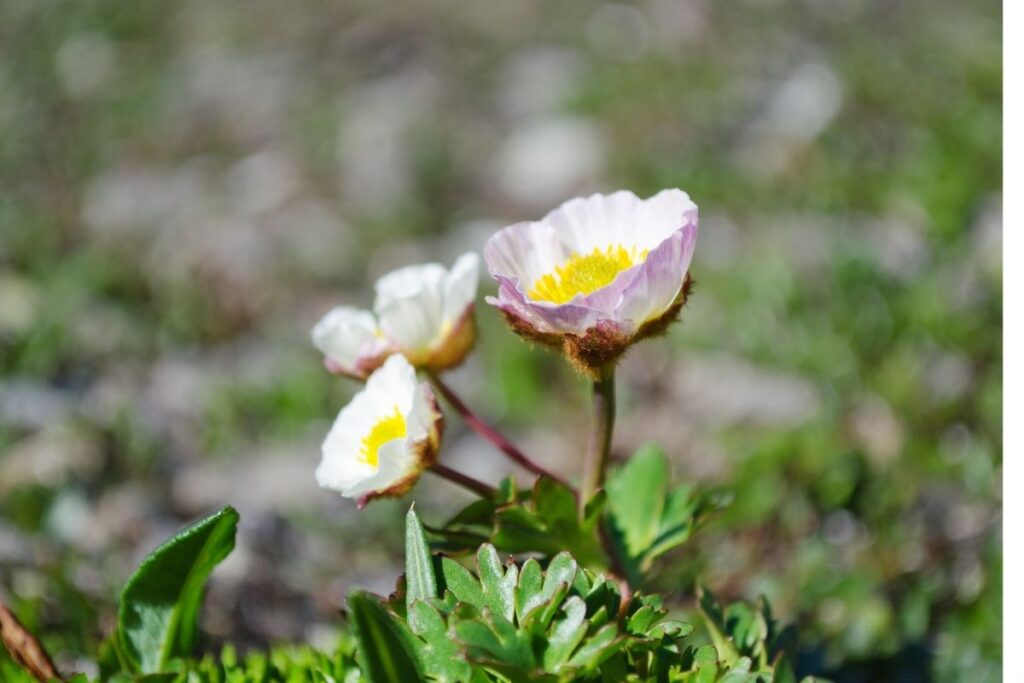
It prefers altitudes above 2300 metres. The pink tint on the petals varies in intensity or may be absent. Glacier crowfoot, which is found on the Finsteraarhorn at 4270 metres above sea level, holds the altitude record for flowering plants.
Super-performer – capable of photosynthesizing much more efficiently than plants growing at low altitudes.
8. Pygmy Buttercup
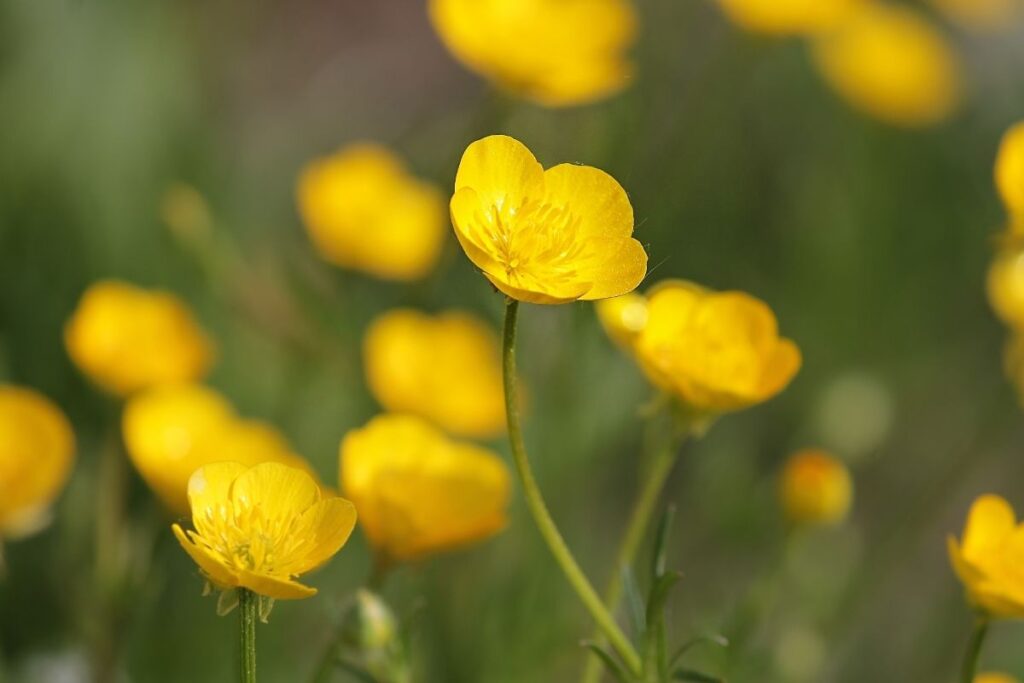
The pygmy buttercup is found only in the snowy valleys of Switzerland’s Macun plateau. Its tiny yellow flowers open in July or August.
9. Alpine Toadflax
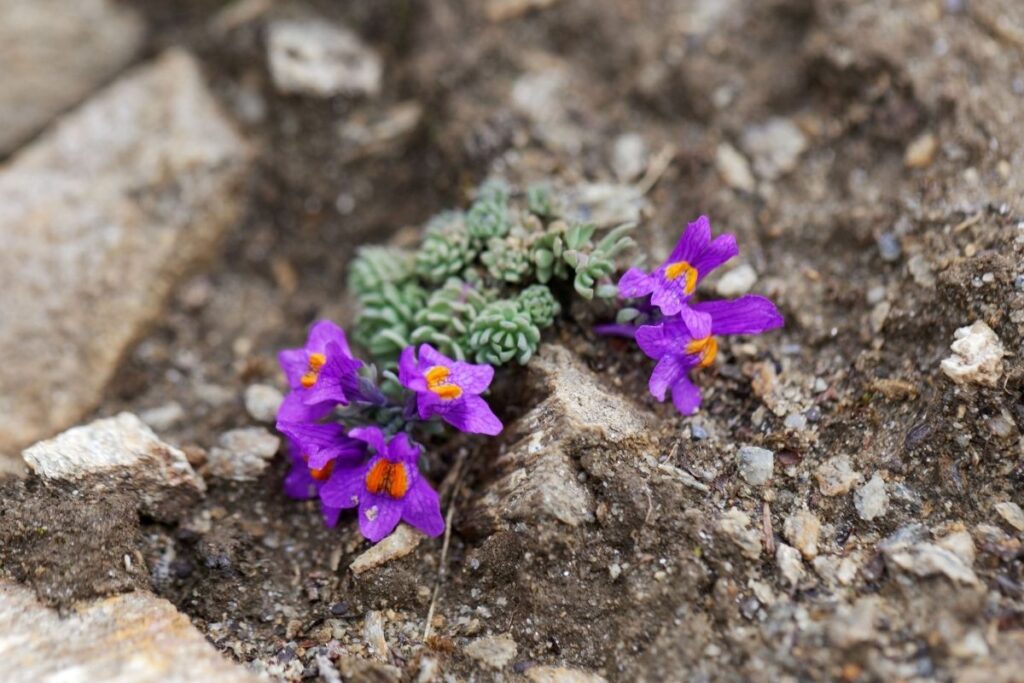
The Figwort family includes Alpine toadflax. This robust plant can be found on limestone or dolomite scree up to 3000 metres high. You’re most likely to see it on Murter, the inner Val Plavnavalley, and the Fuorcla Trupchun in the National Park.
10. Rhaetian Poppy

At 2650 metres elevation, the Rhaetian poppy grows in the midst of steep screes at the Fuorcla Val dal Botsch. Limestone debris is a very hostile environment in which only a few plants can survive.
Long, flexible taproots anchor the plant in the scree, providing it with water and nutrients. The Rhaetian poppy is a typical eastern Alpine plant that only grows to the east of the river Inn.
11. Vanilla Orchid
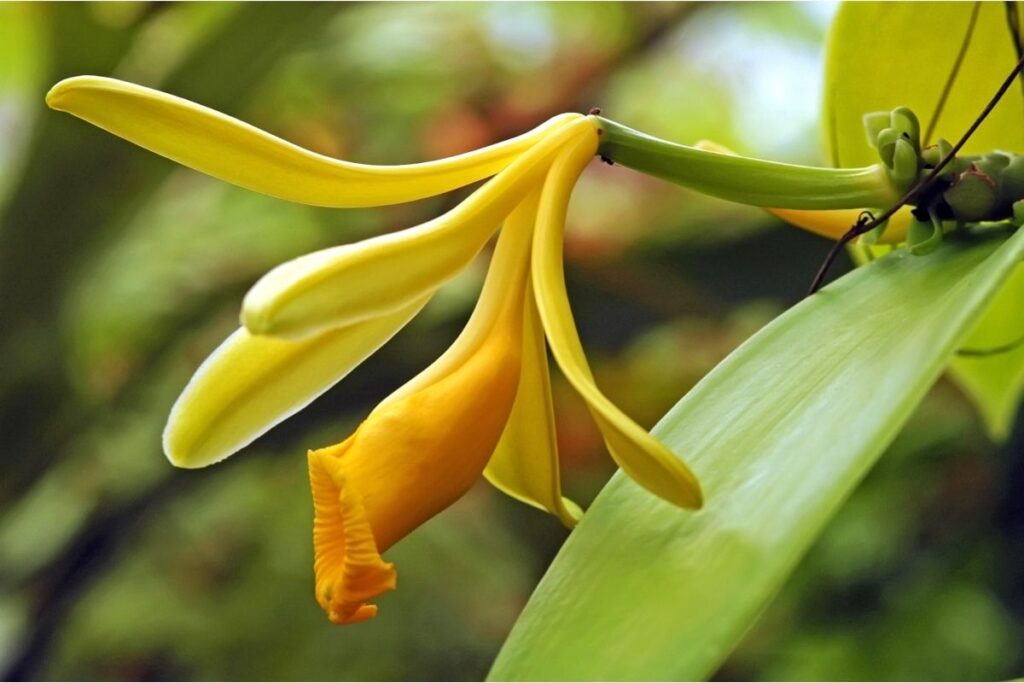
In July, you’re almost certain to come across the blackish-purple vanilla orchid when walking in grassy limestone meadows above the forest boundary. You may even find the more rare rosy variety that you see here. Don’t miss out on the chance to smell this flower’s distinctive vanilla scent.
12. Pinnate – Leaved Ragwort
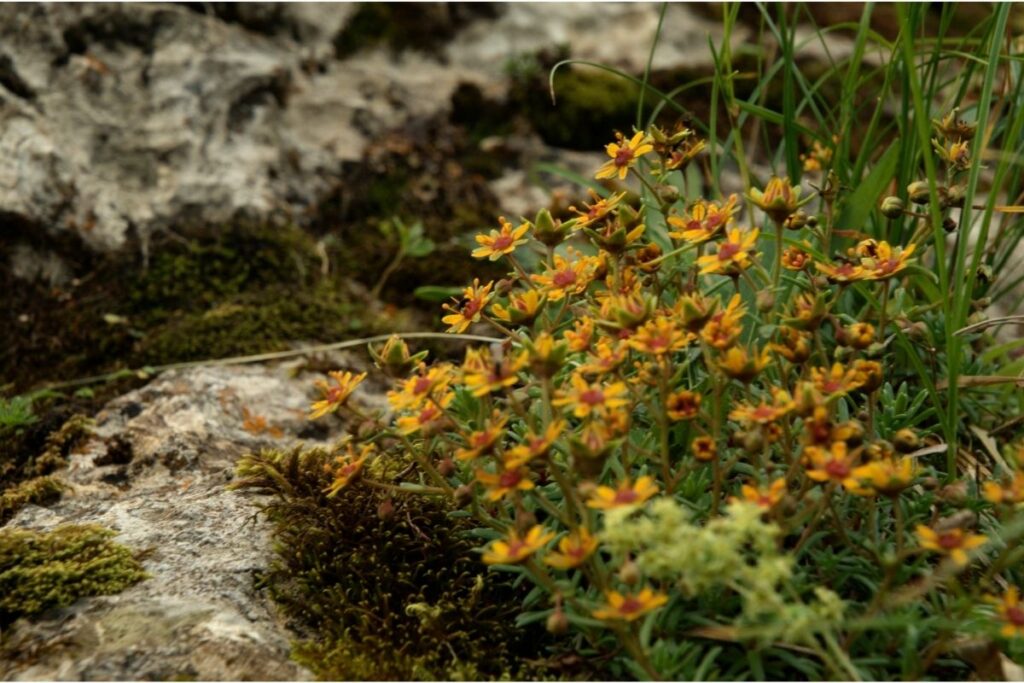
A lot of people ask about this yellow-orange to orange plant that grows up to 40 cm tall and blooms abundantly in July and August. Pinnate-leaved ragwort is an eastern Alpine plant that only grows to the east of the river Inn.
It’s most common in mountain pine forests and stony, dry meadows. Though the plant’s flowers are similar in colour and appearance, it should not be confused with arnica. Its white, hairy seedheads are very noticeable.
13. Alpine Aster

In the Alps, yellow flowers from the daisy, rose, primrose, gentian, and buttercup families can be found. On high rocky ground, I came across the sunny Chamois Ragwort (pictured above) as well as another member of the daisy family, the Golden Hawksbeard.
Arnica is a common and innocent-looking flower that is actually poisonous, as is the pretty Globeflower.
Wolfsbane is less appealing but even more poisonous—I didn’t see these flowers on my own walks, but it serves as a reminder to avoid Swiss alpine flowers or mountain flowers anywhere in the Alps of Europe.
14. Fairy Thimble Bellflower

Bellflowers from fairy thimbles are light blue. The basal leaves are rounded and toothed. Fairy’s thimble is a spreading plant that grows on limestone and dolomite rocks and screes, embedding itself into the soil.
15. Mountain Avens
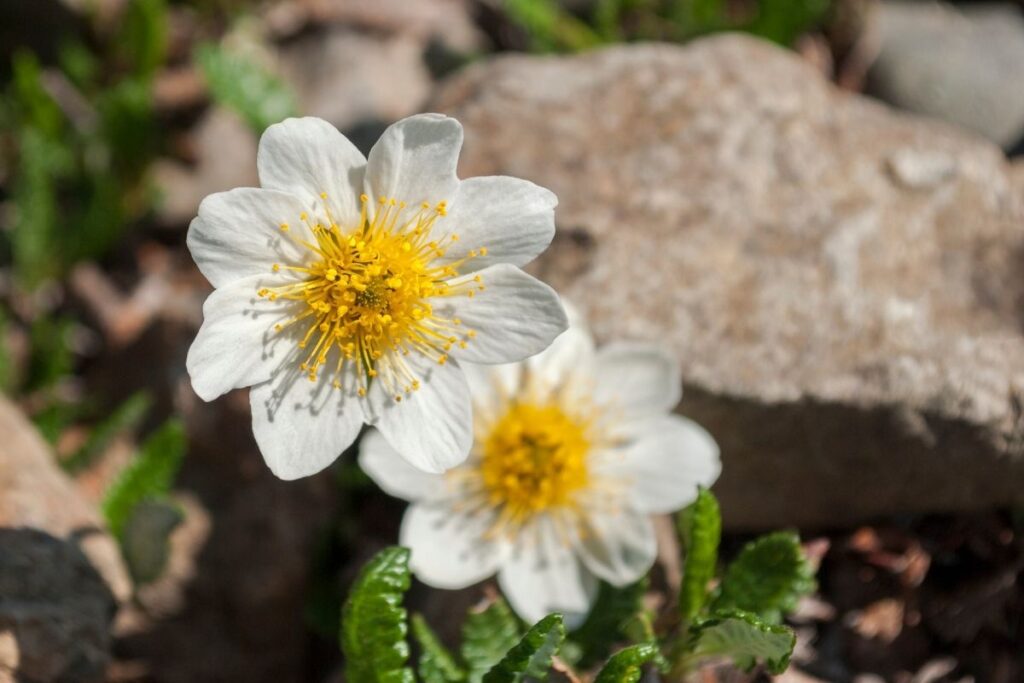
The National Park’s alpine meadows are carpeted with this arcto-alpine plant. Its woody stems creep along the ground, preventing erosion. The flower, which is appropriately named in Latin, has eight petals. Long, feathery seeds have long forms.
16. Delweiss
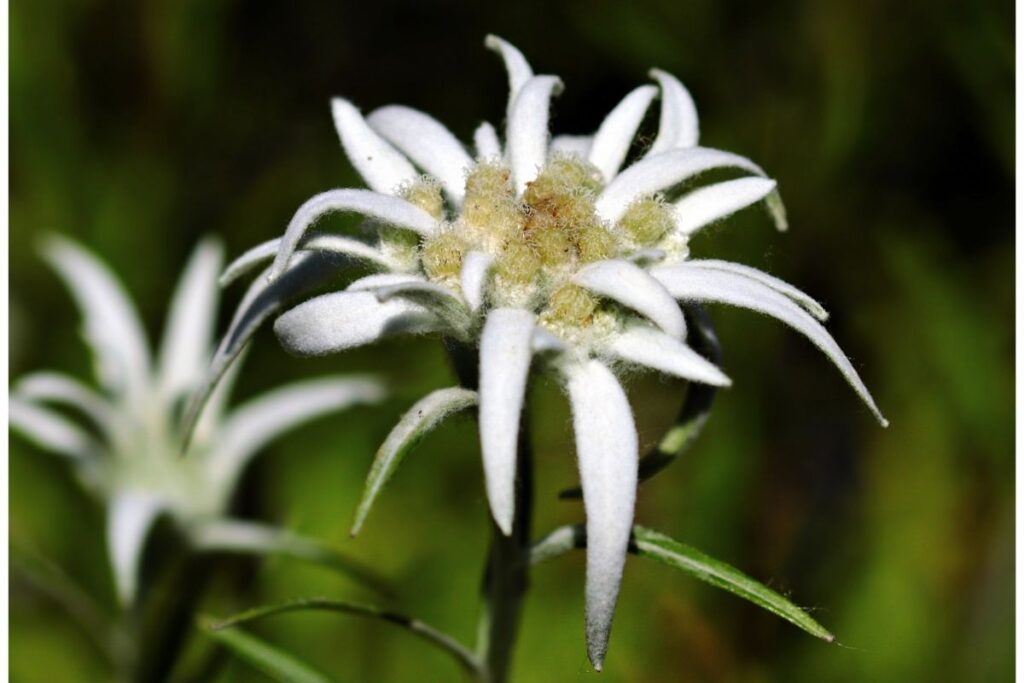
Over the last two centuries, edelweiss has been harvested in such large quantities that it was almost extinct. It is quite common in its natural habitat. It thrives on sunny calcareous slopes up to 3000 metres in elevation.
The flowers are small and yellowish-white, growing in a cluster, and are surrounded by prominent woolly, white bracts that give the flowerhead its distinctive star shape.
17. Alpine Clematis

The alpine clematis produces blue-white flowers that measure 4 to 6 cm in height between June and July. This plant is frequently overlooked as it scrambles through other bushes. It occurs in a variety of places along the footpath from Zernez to Cluozza.
18. Striated Mezereon/Common Mezereon
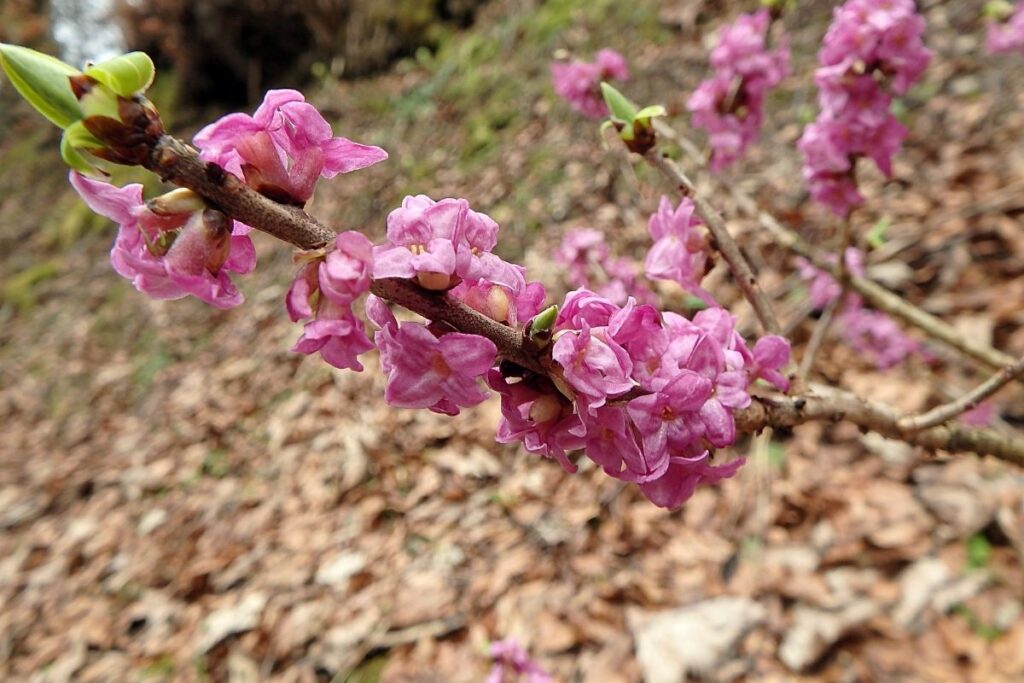
Both of these daphne species are small shrubs that are poisonous. The more common of the two is striated mezereon in the National Park, particularly in mountain pine forests. The common mezereon flowers before it has any leaves at the end of April or beginning of May.
Scarlet-red berries grow on the bushes in autumn. Striated mezereon is one of the most common flowering plants in the National Park’s mountain pine forests. Its scent fills the air in June. Brownish-orange and oval in shape, its berries are.
19. Cowberry
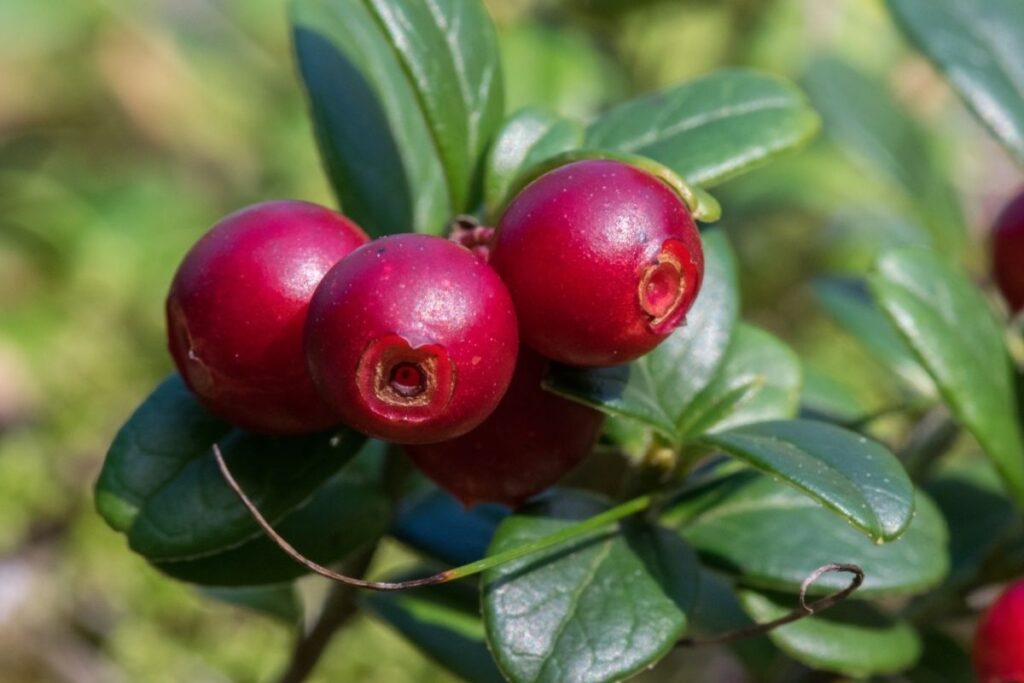
The cowberry is widely distributed throughout the National Park’s mountain pine forests, whereas the bilberry or whortleberry prefers calcareous soils. Cowberry leaves are shiny and “leathery.” The flowers are white, and the berries are red.
20. Lady’s Slipper
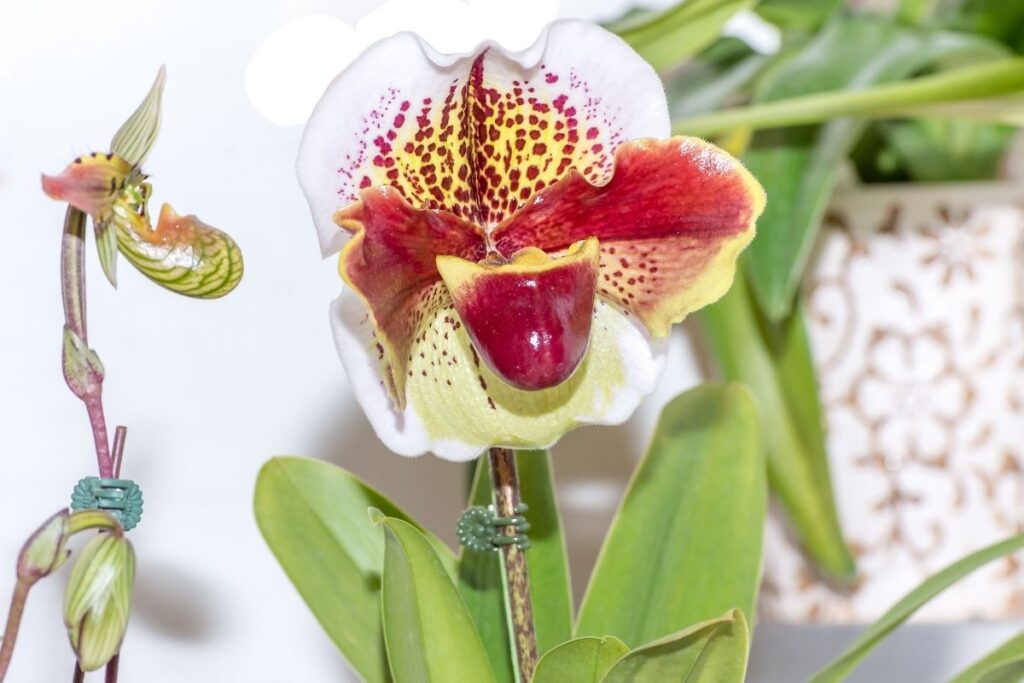
This attractive Orchid species thrives in open woodland on calcareous soil. It is rare in the National Park, and it does not grow above 1900 metres elevation. It’s most likely to be found at the entrance to the S-charl valley in the San Jon woods. This plant is extremely rare today, and it is strictly protected.
21. Purple Saxifrage/Delicate White Blooms
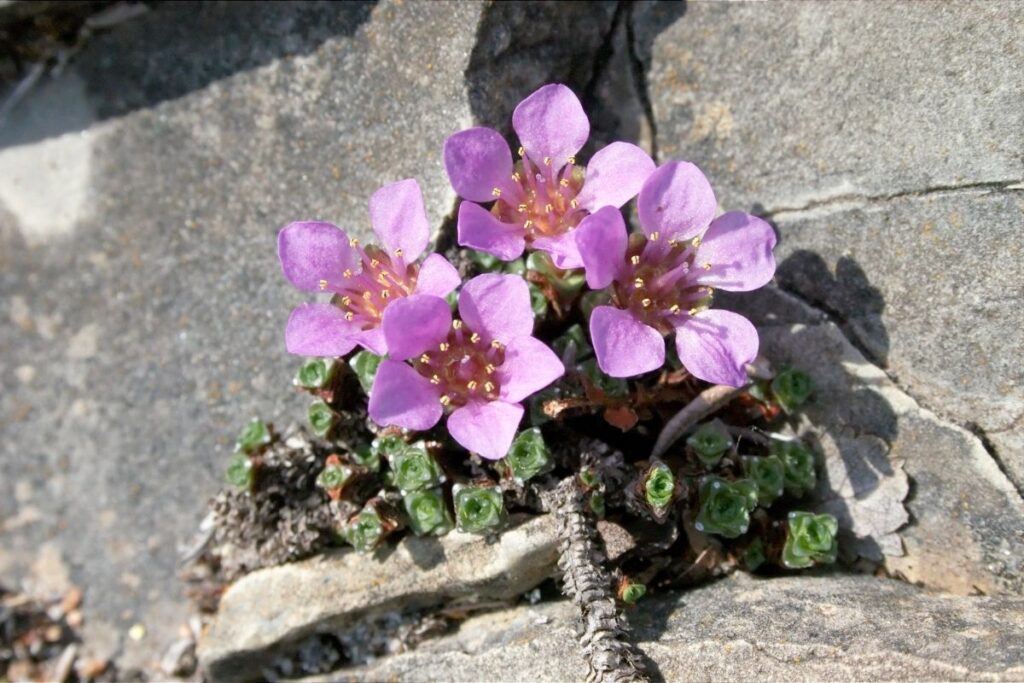
White flowers are some of the most beautiful in the European Alps, including the famous Edelweiss, which is Switzerland’s national flower—though forever linked to Austria for fans of The Sound of Music! While the Mountain Avens is a true rose, the Christmas Rose is one of several white alpine buttercup varieties.
Mossy Saxifrage is pictured and was found on high rocky ground, and there are two white varieties of saxifrage. Pure white Swiss Rock Jasmine (shown earlier in pink) can also be found. Aside from water, the enigmatic Scheuchzer’s Cotton Sedge is discovered.
This was growing high in the mountains above Zermatt, beside the Riffelsee alpine lake. Unless you count the cheerful geraniums displayed on every chalet balcony, it may take some searching to find a true red flower in the Swiss Alps.
In high grassland, I was able to spot the rarely-seen (and wonderfully named) Black Vanilla Orchid. A visiting Burnet Moth perfectly matched the black and red theme!
Conclusion
Swiss Alpine flowers in full bloom are one of the most beautiful sights in the Alps mountain range. A short hike up any mountainside will reveal a variety of Swiss mountain flowers, including primroses and heathers.
If you get the chance to gaze upon the variety of beautiful alpine flowers blooming in the Swiss Alps, then hopefully this list will help you identify everything you find to improve your knowledge. Happy hunting!







